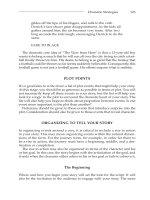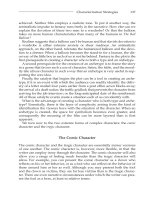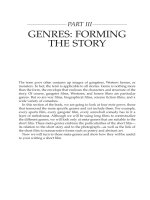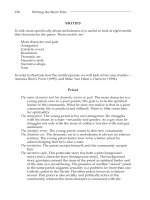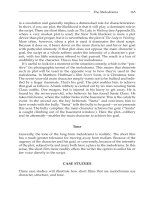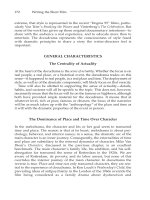Tài liệu Writing the short film 3th - Part 19 ppt
Bạn đang xem bản rút gọn của tài liệu. Xem và tải ngay bản đầy đủ của tài liệu tại đây (129.02 KB, 7 trang )
of television, even the day-long production of a soap opera. The pattern of
the structure must be quickly understood and accepted by the viewer. One
final comment about the mockumentary: this frame affords many opportu-
nities for humor. The more outrageous the humor, the more likely the story
will succeed. If your goal is to make a humorous film, the mockumentary is
a natural story frame.
The Comedy
The mockumentary is one particular comedic story frame; the writer has
other options to choose from, as well. Comedy runs the gamut from farce,
which is principally visual, to more sophisticated forms, where character
and dialogue are more important. If the idea is character oriented, what are
the characteristics that lend themselves to comic opportunity? If they are
physical, the comedy is aimed at the character; to put it another way, we
laugh at the character. If the characteristics are more behavioral, we have a
broader band of comic opportunity. We needn’t laugh at the character, but
we may laugh with the character. How does the source of humor blend with
your attitude about the idea? If we laugh at your character, in other words,
does it undermine or support your idea?
Similarly, if your idea is situation driven, do you want us to see your char-
acter victimized by the situation or victorious over it? In each case, does the
approach support or undermine your idea?
Another approach is to examine what humor, rather than a more straight-
forward approach, will add to the story. The humor, aside from its under-
standable appeal, should bring other narrative dividends. For example, the
fact that the balloon in The Red Balloon does the unexpected (it follows the
boy and later displays a mind of its own) is humorous, but it also humanizes
the balloon. Through humor, the balloon becomes the boy’s friend rather
than remaining an inanimate object.
Using comedy should help your story. It should make your story seem
fresh, and it can, if deployed well, energize your story. Comedy, whether far-
cical or cerebral, visual or verbal, can help you frame your story in such a
way that your idea is strengthened.
The Satire
Satire is a very particular form of comedy. It is more savage than other forms,
because the object of the satire, in the mind of the writer, deserves to be
ridiculed.
116 Writing the Short Film
Ch10.qxd 9/27/04 6:07 PM Page 116
There is a long tradition of satire, from the Greeks through Kurt
Vonnegut, Terry Southern, Luis Buñuel, Salvador Dalí, Eric Rohmer,
Michael Verhoeven, Errol Morris, and Lizzie Borden. The key decision for
the writer considering satire is whether the target of derision merits the
treatment. The form works best when the target is important or well-
known, because the bigger the target, the more likely the target is a can-
didate for satire. Modest subjects will appear ineffective when presented
in a satire.
Satire is a genre of excess—excessive humor and exaggerated character,
story, and language. The rules of realism are readily bent in this genre.
Examples of subject matter successfully treated in film satires include
middle-class values (by Buñuel in L’Age d’Or and Lizzie Borden in
Working Girls), a shameful history and a community’s attempt to hide it
(Michael Verhoeven’s The Nasty Girl), and the excessive power of televi-
sion (Paddy Chayevsky’s great script Network). Other notable targets are
the health care system in the United States (Paddy Chayevsky’s script
“The Hospital”) and in Great Britain (David Mercer’s Britannia Hospital),
and, in one of the greatest film satires, nuclear war (Stanley Kubrick and
Terry Southern’s Dr. Strangelove). Satire is a very free writing form, but it
does involve the constraints of the scale of the subject and of the attendant
idea. The larger the subject, the more likely that the frame of satire will be
effective.
The Fable
Fable, a term most used in the sense of a short story
devised to convey some useful moral lesson, but often
carrying with it associations of the marvelous or the
mythical, and frequently employing animals as characters.
Famous examples include Jonathan Swift’s Gulliver’s
Travels and George Orwell’s Animal Farm.
1
If your idea is best presented with the elements of moral lessons, the
mythical, and animal characters, the fable can transport your idea from the
realistic to the fantastic. Although the fable may pose particular filmmaking
challenges, it can be done. Jean-Jacques Annaud’s The Bear is a recent exam-
ple.
Fables require a powerful moral at their center; without it they can seem
preachy. If you are going to use the fable to frame your story, consider
whether the idea can carry its moral freight. Keeping this requisite in mind
may help you freshen up the other narrative properties so that you avoid
Dramatic Strategies 117
Ch10.qxd 9/27/04 6:07 PM Page 117
the pitfalls. If you can avoid them, you may well have a charming and
fresh story.
The Morality Tale
The morality tale is an allegorical story whose intention, like that of the fable,
is to take a position on an issue. The goal of the morality tale is to offer a life
lesson to those who would veer in another direction. The key difference
between the morality tale and the fable is the use of human beings rather
than animals in the story.
If your idea lends itself to allegory and seems to serve as a life lesson for a
particular group—adolescents, young women, elderly men—the morality
tale could be a very useful device.
As a form, the morality tale seems fresher, more creative, than a more real-
istic approach. The danger, however, is that your audience may not be recep-
tive to the treatment if it is too simple and is interpreted as being aimed at
young children rather than adults. This is the most common problem asso-
ciated with using the morality tale as a framing device.
The morality tale offers the widest possibilities for stories. Your story
can be as simple as the tale of a property-tax collector and a property
owner, or a script about the origins of war, such as Norman McLaren’s
great short film Neighbours. There are numerous collections of morality
tales that can illustrate the form for you. Reading them will help you
appreciate the shape of this particular form.
2
Elizabethan drama, such as
the plays Macbeth and Julius Caesar, is also a good source for morality
tales.
The Journey
The journey has a broader shape than the morality tale or the fable, but
because it is so often used, we include it as a shaping option.
The journey is the oldest, truest, most inescapable shape
for a story. From the nursery story to biblical narrative to
contemporary novel, someone is always setting out from
home.
3
Whether the idea revolves around life as a journey, or a specific journey,
the form offers a wide range of opportunities. Also, as a form it is more open-
ended regarding interpretation than the morality tale, fable, or satire. If you
118 Writing the Short Film
Ch10.qxd 9/27/04 6:07 PM Page 118
are not entirely sure how you feel about a subject, the journey is a safer form
to undertake.
The Ritual Occasion
The ritual occasion is another general shaping form, but it is less open-ended
than the journey. Using this shape emphasizes a particular happening. It also
has implications, particularly for the character: either the character will
achieve greatly or fail greatly in the course of the event.
One of the benefits of using the ritual occasion as a shaping device is that
it concentrates the drama of the story, creating a useful intensity and a natu-
ral rise to the story. Once you determine how you want the audience to feel
after the event, you will have a strong sense about whether the ritual occa-
sion is the best shaping device for your idea.
VOICE
Once you decide upon the shape that will frame your story, you need
to bring to bear the operating principles that will help the audience
move through your story. How we feel about the events of a story and a
character is colored by the voice of the writer. If no voice is present, the script
seems shapeless. The first operating principle to decide on is voice, your atti-
tude toward the idea. How do you want us to feel at the end of your story?
In order to articulate a tone, you need to make a number of choices. How
close do you want us to get to the events of your story? If you want to get us
deeply involved, choose events that place the character in intense situations,
close to the dramatic core of the story. If, on the other hand, you want us to
have a more distant relationship with the events, position the character far-
ther from the dramatic core. In fact, if you want to create a sense of detach-
ment, you should employ irony, to distance us from the story. That distance
will allow us to reflect upon the character and what is happening to him or
her. This sense of detachment or irony is particularly useful in the morality
tale, in the mockumentary, and in the satire. Is it useful to you to interpose
yourself so definitely into the story?
TONE
The second operating principle, tone, is an offshoot of voice. The choice of
tone gives guidance about how we should feel about plot and people. If you
Dramatic Strategies 119
Ch10.qxd 9/27/04 6:07 PM Page 119
are telling a love story from a cynical point of view, your tone will be cyni-
cal. On the other hand, if your goal is to describe a positive relationship, a
romantic tone may be more appropriate.
The writer creates tone by the type of observation incorporated into the
story. If romance is your goal, the beauty of the day can be as useful as the
beauty of the date.
Beyond the issue of visual detail, a second element of the tone is the rela-
tionship of your main character to the screen story.
4
Is the character in the
middle of the story, or positioned as more of an observer? Every decision
you make about dialogue, visual detail, and narrative structure will support
a particular choice of tone.
CONFLICT AND POLARITIES
The central role of conflict in the development of your story cannot be
overemphasized. Throughout your story, the struggle of character against
character, character against setting, character against community, and char-
acter against society mines the dramatic possibilities. You should maximize
those dramatic possibilities in order to tell your story.
This may seem synthetic, mechanical, and forced, but it must be that way.
Unlike real life, dramatic life relies on coincidence, intensification, and arti-
fice in order to fulfill the dramatic intentions of the writer. Real life also has
its conflicts, but they are not quite as accelerated as dramatic life. A writer
must use conflict to advantage in the story.
You should make the most of all the opportunities in terms of conflict that
the frame you’ve chosen yields. You should also highlight the opportunities
that voice and tone choices offer, as well. Clearly, a more distant voice neu-
tralizes some of the opportunities for conflict. Nevertheless, you should
make the most of those that remain.
Use polarities to facilitate conflict. Conflict is amplified by polarities of
character, behavior, goals, and situations. It is crucial for you to use as many
polarities as possible; they will make your job as a writer easier. Here are
some illustrations of useful polarities.
A physical polarity is readily apparent in the blind detective. A detective
investigates a crime. How can he investigate (see) and solve the crime
(interpret) if he is blind? Here the opposites pose more conflicts within the
character.
A behavioral polarity would be represented by the sadistic minister in
Ingmar Bergman’s autobiographical screenplay The Best of Intentions. The
minister is expected to be loving and filled with charitable feeling; instead,
he is demanding and cruel when it comes to his own family. We expect a
minister who is father to his congregation to be a great father to his family,
120 Writing the Short Film
Ch10.qxd 9/27/04 6:07 PM Page 120

